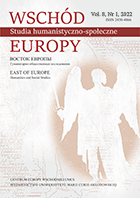Format 17+1 jako przykład chińskiego rozumienia
i praktyki polityki zagranicznej
17+1 as an example of Chinese understanding and practice of foreign policy
Author(s): Artur LuberdaSubject(s): Politics / Political Sciences, Politics, International relations/trade
Published by: Wydawnictwo Naukowe Uniwersytetu Marii Curie-Sklodowskiej
Keywords: China; 17+1; international relations; shi; guanxi; tianxia
Summary/Abstract: The main purpose of the article is to show the foreign policy of the People’s Republic of China from a different than western analytical perspective. According to author, not including in analysis of Pekin’s politic it’s different experience and view in international relations is the reason of their too western/European approach. In the result the picture is distorted by the western conceptual grid which makes it difficult to properly read and predict PRC moves in the international arena. In the article main concepts visible in the Chinese political culture, are talked over. As their roots reach to the classical philosophy and political practice of Middle Kingdom, they are also visible in contemporary Chinese foreign policy. Mentioned concepts are tianxia (all under heaven), ba (hegemony), shi (practically almost impossible to translate in one word) and guanxi (interpersonal connections). In the article all of them were defined and discussed, to show the reader China’s different approach to the international relations. Additionally, in the article author makes a bid to analyze Pekin’s international organization – 17+1 under the presence of above concepts. As it is shown, all of them can be found in it. 17+1 itself may be therefore an example of a universalism of Chinese foreign policy. Independently of the country toward which it is aimed, it is always formed by the concepts described in an article.
Journal: Wschód Europy. Studia humanistyczno-społeczne
- Issue Year: 8/2022
- Issue No: 1
- Page Range: 87-96
- Page Count: 10
- Language: Polish

